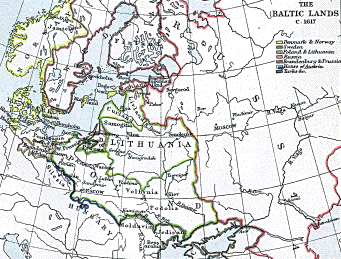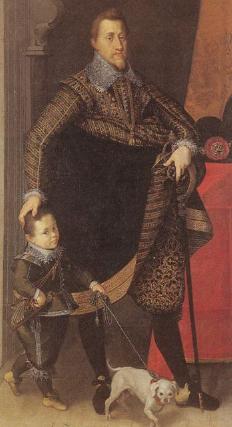The Thirty Year War

The Baltic Lands ca. 1617
At the start of the seventeenth century, the religious protests of the previous century had apparently stabilized. The English defeat of the Spanish Armada in 1588 meant that England remained Protestant. The Peace of Augsburg in 1555 established Catholic and Lutheran areas in Germany. The Edict of Nantes in France, issued by the Protestant-turned-Catholic King Henry of Navarre in 1598, allowed and protected the Huguenots freedom of worship in Huguenot cities.
The biggest problem with this arrangement is that as yet nobody seriously considered religious freedom on an individual level. Whenever a religious group sought to form, it also either isolated itself from the surrounding community or it attempted to have itself become the official religion. The Peace of Augsburg, for example, specified where in Germany Catholics were allowed, and where in Germany Lutherans were allowed. It excluded everyone else, such as Calvinists.
In a time of religious turmoil, this meant political turmoil as well. In 1618 it resulted in a long-lasting domino-like war of religion, aggression, and fear.
- In Bohemia, many areas that had allowed for Lutheran toleration under the treaty of Augsburg had become Calvinist.
- The Hapsburg Catholic King Ferdinand II of Bohemia used the spread of Calivinism as an excuse to rigidly apply Augsburg to root out Protestantism and impose Catholicism upon Bohemia.
- The Bohemians rebelled and chose their own Calvinist king. Not only did this disregard the Peace of Augsburg, it also threatened the basis of the German kingdoms.
- Spain supported Ferdinand with troops and money. Bavaria joined with the Austrian Hapsburg Ferdinand, while Lutheran Saxony maintained neutrality. The Bohemian rebels were crushed, and their estates confiscated.
- Lutheran Denmark, fearing a Catholic advance, attempted to intervene on behalf of the Bohemian Lutherans who were now under a Catholic king. The Danes were repulsed, however.
- When the Danes retreated back into Denmark, Ferdinand and his alliance followed all the way up to the Baltic.
- This got Sweden involved. Lutheran King Gustavus Adolphus intervened on behalf of the Danes and the Calvinists, against the Catholics under Ferdinand.
- Spain increased their aid to Ferdinand. Catholic France and the Pope supported the Lutheran Gustavus over the Catholic Ferdinand, because the Hapsburgs represented Spain. France did not want Spain to gain too much power in Germany and the Baltic.
- When the Catholics sacked Magdeburg in Lutheran Saxony, Saxony discarded their neutrality and joined on the side of the Swedes and Calvinists (and the Pope!) against the Hapsburgs.
- Gustavus seemed poised to smash the Hapsburgs, when he died at the Battle of Lützen in 1632.
By this point, political concerns had overridden religious concerns. France and Spain continued to fight by proxy for control of the Rhineland for another sixteen years.
The Thirty Years’ War ended with the Treaty of Westphalia in 1648. Westphalia continued the territorial principle of religious adherence, merely adding Calvinists to the mix. France emerged as the most powerful of the European states while Rome’s influence fell considerably.
What began as an attempt to impose imperial rule on Germany in Bohemia under the guise of re-establishing Catholicism, and continued with the Pope fighting the Catholic expansion of Spain, ended with the rise of France and the decline of Papal power.
Germany also declined, as it fragmented further into several smaller political entities.
The Thirty Years’ War was not just a war between different religions and the great powers of the world. It was also a war between different kinds of militaries. Before he died, Gustavus Adolphus won great victories against the German Catholics because of his relatively modern military.
The Swedish army under Gustavus consisted of professional soldiers organized into small tactical units and supported by mobile artillery. Each kind of unit cooperated in pre-planned wedge formations. This contrasted with the massed and square formations more common in other armies of his day where each kind of unit (pikemen, musketeers) basically took their turn.
Game-world applications
So what does this mean for your game world? Wars do not have to be simple conflicts between two well-defined opponents. Participants in a war can shift according to where the war has spread and who else has already participated. Some of the participants can join based on their religious beliefs or national affinities; others in order to avoid some feared political outcome or to achieve a desired political outcome.
Because of this interplay, political leaders will sometimes wish to constrain their military leaders so as to avoid bringing their neutral enemies into the fray. At the same time they will try to goad their counterparts on the other side into provoking neutral entities into joining battle.
Imagine a world in which humans, goblins, orcs, and elves are all living in precarious balance. There are multiple factions of each. Elves are allied with some factions of humans but in an uneasy truce with others. Orcs and goblins generally fight each other but have similar beliefs, and elves and men tend to be opposed to orcs and goblins.
The humans are, in this area, three groups: the Terakians, the Pidophians, and the Divaxians. The Pidophians and Divaxians live on opposite borders of the goblin-lands, and share similar religions. Many goblins live among the Pidophians and the Divaxians, while many Pidophians and Divaxians live among the goblins.
- A new leader among the Terakians decides to force unification on the Pidophians, in order to unify the human nations. He secures the neutrality of the elves and the gains the support of the orcs in a secret treaty. The orcs have been worried at the growing friendliness of relations between the humans and the goblins.
- Pidophians and local goblins fight back, but lose. Now, the goblin nation gets involved on behalf of their expatriate tribefolk, but is also pushed back.
- Now the Terakians are vastly expanding their soon-to-be-unified human nation. The elves remain neutral, but the Divaxians see a massive influx of goblin and Pidophian refugees. The Divaxians try to retake the goblin territories and Pidophian lands from the Terakians.
- Falling back now against the momentarily combined goblins and two human nations, the Terakians risk open alliance with the orcs.
- The elves panic at an alliance between humans and orcs, and they join the fight on the side of the goblins, Pidophians, and Divaxians against the Terakians and the orcs, and general mayhem ensures.
At various points in this timeline, the player characters can be warriors, merchants, or diplomats. They might take part in the overall war; they might be conscripts caught up in one side; they might attempt to avert or provoke war between any two or more of the warring parties; they might remain local and try to protect their local community against the depredations of both sides.
- Ferdinand II, Holy Roman Emperor at Wikipedia
- “Ferdinand II, Holy Roman Emperor (July 9, 1578 - February 15, 1637), from the house of Habsburg, ruled 1620-1637. Originally Archduke of Styria, his appointment as King of Bohemia was one of the causes of the Thirty Years’ War.”
- Thirty Years’ War at Wikipedia
- “The Thirty Years’ War was fought between the years 1618 and 1648, principally in the central European territory of the Holy Roman Empire, but also involving most of the major continental powers. Although it was from its outset a religious conflict between Protestants and Catholics, the self-preservation of the Habsburg dynasty was the central motive.”
- Christianity•
- I have this as the “Horizon History of Christianity”. If it is the same, it tends to be somewhat biased towards parliamentarian worship, but it is still a well-written and interesting history of Christianity from its birth to “the modern age”, that is the late 1950s.
- National Geographic Atlas of World History•
- A good collection of maps, photographs, and short surveys of the times and places chosen.
- Atlas of World History•
- Massively cool collection of maps showing political divisions and the flow of ideas throughout history, especially after the dawn of civilization.
More gaming history
- The Cult of the Cult of Gygax™
- It was never a secret to us back in the day that the staff at TSR played the game themselves, and that they played the game with custom rules and custom worlds.
- Was table-top gaming inevitable?
- Gods & Monsters rolls an 18 for age today, pioneer game writer Greg Stafford died two weeks ago, and stories about the early days of gaming has me wondering, was the discovery of table-top gaming a perfect storm, or was it inevitable?
- The First Language
- Scholars once believed that, or seriously discussed whether, Hebrew was the first language of mankind. In a fantasy game, there really can have been a first, holy language of the gods.
- Currency and economic policy in the middle ages
- Prices, credit, and currencies. If you know the system, you could make a mint!
- House of Gold, House of Passages
- The emperor Nero’s House of Gold sounds like the backstory of a great megadungeon right under the adventurers’ sandaled feet.
- 18 more pages with the topic gaming history, and other related pages

